2021 marks ten years since the Tohoku earthquake and tsunami and twelve years since the Black Saturday bushfires. In this decade Australia and Japan have experienced an increase in extreme environmental events which have impacted our communities and cultures and opened up questions about the contributing factors of our human activities.
Art and design practices offer us opportunities to unpack and better understand the interconnections between these social and environmental ecologies. Art in this sense is not an illustrative instrument nor a replacement for “hard science.” Rather it offers us poetic and affective experiences through which new perception and knowledge can emerge; this includes convergence with political action, new ways of feeling and being in the world and ways of practicing and translating identity and culture.
Mutable Ecologies considers how innovations in art are interrogating the effects of changing environmental conditions to offer new insights and awareness of ecological futures. Mutable Ecologies comprises leading creative practitioners from Australia and Japan who will present their work and research through an online exhibition, performances and public discussions.
Artists include Don’t Follow the Wind, Hikaru Fujii, Yoichi Kamimura, Yuko Mohri, Clinton Naina, Yhonnie Scarce, and Polly Stanton. Curated by Kristen Sharp, Philip Samartzis, and Andrew Tetzlaff, RMIT University.
Public programs are co-curated and co-presented with Pippa Dickson and Jala Adolphus at Asialink Arts at The University of Melbourne. The final public forum, Inhabiting Extremes, will include speakers Miranda Nieboer, Fumitaka Nishino, Motoko Okumoko, Yoshihiro Nakayama, Malte Wagenfeld. For more information and to register, visit here.
Mutable Ecologies is supported by the Australian Government through the Australia-Japan Foundation of the Department of Foreign Affairs and Trade. Project partners include Asialink Arts at The University of Melbourne, Musashino Art University, and NTT InterCommunication Center (ICC). With support from RMIT University School of Art and RMIT University CAST research group.







